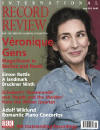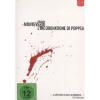Texte paru dans: / Appeared in:
*

International Record Review - (06/2012)
Pour
s'abonner / Subscription information
EuroArts
EA2058928

0880242589286
Consultez toutes les évaluations recensées pour ce cd
~~~~ Reach all the evaluations located for this CD
In the finest Poppea production I’ve encountered (Glimmerglass Opera, 1994), Jonathan Miller placed the piece in a formal seventeenth-century milieu, with David Daniels’s Nerone and Dana Hanchard’s Poppea communicating sexual attraction through vocal inflection and mesmerizingly subtle body language. Nothing could be further removed from Ole Anders Tandberg’s 2010 modern-dress production for the Norwegian National Opera, in which sex and violence are given flat-out, in-your-face prominence. Certainly this work can handle both approaches, but Tandberg’s vision does make for exhausting viewing.
The set is minimal — a huge, white, sharply curved floor. The performance could have been shot in black and white; everyone is lit to look stark and blanched in his or her flesh tones. The red of singers’ lips (also their blood, much of which flows during the performance) is the only colour onstage. The men generally wear suits, but the women’s costumes are cleverly chosen, beginning with Fortuna decked out in a white fur coat and bouffant hair, clearly one of the ‘beautiful people’. Poppea is first seen in a white bathrobe (the voluptuously Rubens-esque soprano Birgitte Christensen makes that garment more seductive than one might imagine), later sporting a girlish white gown for her coronation. Ottavia looks appropriately severe (chignon, pearls, simple sleeveless cocktail dress), while Drusilla is casual in shades and a jumpsuit.
Tandberg, an important theatre director, has created distinct individuals onstage in even the smallest roles (he errs only with Amor, onstage virtually throughout, annoyingly grinning and smirking). Petulant, sex crazed Nerone, shamelessly amoral Poppea, obsessively vengeful Ottavia, and their supporting cast are all portrayed in detail and with terrific theatrical flair. One major departure comes with the Drusilla/Ottone scenes: he’s much more confident and with more backbone than usual, while she’s nearly as predatory as Poppea, practically caressing the dagger with which Ottone intends to kill Poppea.
There are some directorial touches I could have done without, such as having Seneca’s body onstage through both the Damigella/ Valletto and Nerone/Lucano duets (the latter finds the two gents wearing only towels, with the scene’s homoerotic potential skilfully handled by director and singers). Does Nerone need to shoot Ottone? And must we have Ottavia stab the Nutrice (in the sublime ‘Addio, Roma’ farewell, for heaven’s sake)? Ottavia then stabs herself, with Nerone snatching her crown to place on Poppea’s head. The finale is Tandberg’s biggest shocker: various supporting characters still alive at this point (Lucano, the two nurses, the captain Liberto) are now stabbed by the royal couple as they lovingly sing ‘Pur ti miro’ . They walk through a puddle of blood, with Fortuna and Virtù looking on dismayingly as Love smiles. Curtain!
Few operatic portrayals have communicated sheer lust more convincingly than Jacek Laszczkowski’s Nerone. He’s also capable of terrifying nastiness in the confrontation with Seneca. Physically a bantamweight, he carries himself with irrepressible cockiness . More soprano than countertenor, he exhibits a distressingly airy, ‘juice’-less lower-middle but also a spectacularly ringing, thrusting top.
Chnistensen’s Poppea and mezzo-soprano Patnicia Bardons Ottavia are in every way stunning. Each possesses the night rich-toned, flexible instrument for her role, with Bardon masterfully balancing imperiousness with vulnerability, contrasting with Christensen’s overwhelming allure.
Sex appeal also emanates from the opera’s important supporting couple: countertenor Tim Mead’s handsome, handsomely voiced Ottone and Manita Sølberg’s Drusilla, sung in a rather generically timbred light soprano. Tone Kruse (Nutnice) nearly steals the show with her boldly chesty contralto and fabulously earthy characterization. In the travesti role of Arnalta, tenor Emiliano Gonzalez-Toro finds the ravishing lullaby somewhat awkward, but he’s delightful everywhere else. Giovanni Battista Parodi makes a sympathetic, younger-than-usual Seneca (he struggles with the lowest phrases). Except for Amor (unpleasant — almost screamy — in her Act 2 solo), the other roles are well taken, especially Magnus Steveland’s stylistically expert Lucano.
This is film, not video, shot onstage before a live audience, whose presence is forgotten once the performance begins. The filming is loaded with extreme close-ups and much footage captured by a camera lurking high above the stage (unnecessary). In some scenes, another image is occasionally intercut: for example, while Arnalta is singing the lullaby, we briefly see Poppea being crowned by Nerone.
The original-instrument ensemble is proficient technically with Alessandro de Marchi’s conducting generally well judged, even if one questions a tempo now and again. Highly objectionable are the jazzed up interludes between certain scenes (based on elements of Monteverdi’s score, with guitar, flute and trumpet). The recorded sound is harsh rather in keeping with the overall approach to the piece! The DVD booklet provides a track list, a synopsis and a helpful essay.
Despite several memorable portrayals, this
is a supplementary Poppea, not a top choice. The palm among available
DVDs is impossible to award when nine celebrated conductors’ interpretations
are documented, in collaboration with intelligent directors and top-flight
casts. I particularly relish the pairings of Danielle de Niese and Alice
Coote (Glyndebourne), Miah Persson and Sarah Connolly(Barcelona), and Rachel
Yakar and Eric Tappy, the latter a tenor Nerone ( Ponnelle/Harnoncourt
film). How wonderful to have a luxury of choices for this glorious,
eternally provocative masterpiece!
Fermer la fenêtre/Close window
Cliquez l'un ou l'autre
bouton pour découvrir bien d'autres critiques de CD
Click either button for many other reviews


